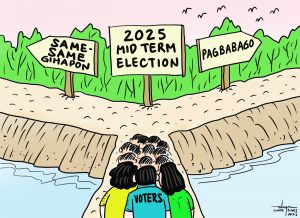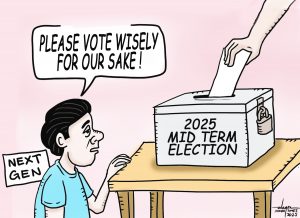It looks like former President Rodrigo R. Duterte (FPRRD) who is now sliding down to become mayor again of Davao City, need not go around the entire area to campaign. His continuous exposure on a nation-wide scale, courtesy of his rift with the incumbent President, is more than enough to instill his name in the consciousness of the city electorate.
And even if the outcome of the Congressional investigation into the alleged extra-judicial killings during his bloody war against illegal drugs will be adverse to him, still it may not create a serious dent in his popularity.
But again, we are certain that the former President cannot afford to be complacent. His opponent Katlo Nograles, young, dynamic, well-educated and full of ideas on how to further develop the city and improve the lot of its people, may be able to capitalize on the outcome of the probe, whether or not it is favorable to the former President.
Besides, the possibility that there are a number of Davaoenos aspiring for a change in leadership, is not remote. Only, that they might not have found the right person or that they are just too afraid to come out in the open for one reason or another.
And who knows, the citizenry may have already grown tired of the so-called “carrot and stick” policy in making the people toe the line to attain the desired objective.
*****************************
When we were relatively a new migrant in Davao City and was still starting our media work as a sideline source of income, we used to cover the Davao City Council. So we attended sessions then. The councilors during those years were the the like of Doming Vidanes, Pantaleon Pelayo, Jr., Ben Amora, Victorio Advincula, Sr., Polyok Castillo, Joe Hizon, later Dado Mahipus who represented the Sangguniang Kabataan and some others who we could not anymore remember their names.
It was the era when the Councilors took to the highest standard and professionalism when they debated issues relative to proposed ordinances introduced in the body. And the debates were not participated only by 2 or 3 members but by many whose ideas were all worthy contributions in the polishing of the proposed measures. Their dexterity never failed to mesmerize observers of Council proceeding then.
But that was an era long gone and very unlikely to be replicated by the present and possibly future crop of councilors. Still, as one saying goes, “Hope springs eternal.”
And while many may not find the recent and current generation of aldermen adept in the conduct of debates on certain issues they may have the ability to undertake studies on subjects, or adeptness in researching and identifying areas where ordinances are needed to address certain situations in the city.
Of course we are not saying that the councilors during that era, and the Council as well as the executive department during that time were not wanting in weaknesses. Actually the two branches of the local government failed in crafting a well-planned future highly urbanized Davao City. Hence we now have a metropolis with commercial and residential areas lumped together and industrial zones concentrated in almost only one sector of the city.
The failure of the Council and executive during that era to see the importance of urban planning is mainly the reason why these days almost every low-lying area in the city gets flooded with just an hour or less heavy rains. And why not when almost all drainage canals are small in width and shallow in depth that immediately overflow when rains comes. And the city has drainage pipes with uneven diameters that impede the flow of waste water.
What about the city’s rivers? Well, for the failure of the Council during that era to pass appropriate measures setting standard pipe dimensions, and absence of regular monitoring teams then and even until now, allow the river banks and the various mouths leading to the seas to be “invaded” by informal settlers thereby constricting the passage of the water.
And the upstream? Again for lack of appropriate local laws and lackluster inspections by concerned city offices quarrying has been unabated for years.
Today planning for a fast urbanizing Davao is several steps behind the existing physical condition of the city based on its development level. But then again, it may already be imperative for our present councilors to consider in their crafting of policies with regards to the city’s physical planning the condition of suburban and peripheral areas where development is fast expanding.
If they succeed in such endeavor it might be the redeeming factor of their lack in prowess of engaging in substantial debates on issues relative to proposed ordinances.


